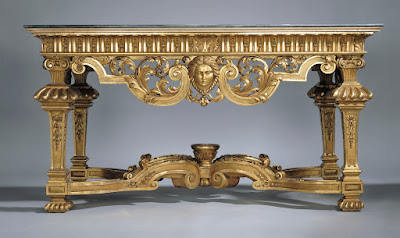 |
| Jean-Henri Riesener Drop-Front Secretary (detail) 1783 oak veneered with ebony and Japanese lacquer panels, gilt-bronze mounts, marble top Metropolitan Museum of Art, New York |
 |
| Jean-Henri Riesener Drop-Front Secretary 1783 oak veneered with ebony and Japanese lacquer panels, gilt-bronze mounts, marble top Metropolitan Museum of Art, New York |
 |
| attributed to Thomas and René Pelletier Mirror ca. 1690 glass, verre eglomisé, giltwood Metropolitan Museum of Art, New York |
 |
| attributed to Thomas Pelletier Pier Table ca. 1705 gilded pine and beech, inlaid marble top Royal Collection, Great Britain |
 |
| attributed to Thomas Pelletier Pier Table ca. 1705 gilded pine and beech, inlaid marble top Royal Collection, Great Britain |
 |
| Anonymous French Maker Folding Stool ca. 1735-39 carved and gilded walnut Metropolitan Museum of Art, New York |
 |
| Anonymous French Maker Folding Stool (detail) ca. 1735-39 carved and gilded walnut Metropolitan Museum of Art, New York |
 |
| Anonymous French Maker Console Tabler 18th century carved and gilded wood, marble top Metropolitan Museum of Art, New York |
 |
| Anonymous French Maker Console Table 18th century carved, painted and gilded oak, marble top Metropolitan Museum of Art, New York |
 |
| Anonymous French Maker Console Table (detail) 18th century carved, painted and gilded oak, marble top Metropolitan Museum of Art, New York |
 |
| Anonymous French Maker Console Table (detail) 18th century carved, painted and gilded oak, marble top Metropolitan Museum of Art, New York |
 |
| Anonymous French Maker Candle Stands ca. 1700 carved and gilded walnut Metropolitan Museum of Art, New York |
 |
| Bernard II van Risenburgh Table en Chiffonière ca. 1760 oak and pine veneered with exotic woods, gilt-bronze mounts Metropolitan Museum of Art, New York |
 |
| attributed to Thomas and René Pelletier Pier Table (built as support for Japanese lacquer cabinet) ca. 1705 giltwood Royal Collection, Great Britain |
 |
| Jean-Henri Riesener Corner Cabinet ca. 1785 oak and mahogany, gilt-bronze mounts, marble top Art Institute of Chicago |
"How do we arrive at a clear conception of an object in space? We first look at its parts singly, then the combination of parts, and finally the totality. Our senses perform these various operations with such astonishing rapidity that they seem to us to be but one single operation, and this rapidity is absolutely necessary if we are to receive an impression of the whole, which is nothing more than the result of the conception of the parts and of their combination. Now let us assume that the poet takes us from one part of the object to the other in the best possible order; let us assume that he knows how to make the combination of these parts ever so clear to us; how much time would he use in doing this? That which the eye takes in at a single glance he counts out to us with perceptible slowness, and it often happens that when we arrive at the end of his description we have already forgotten the first features. And yet we are supposed to form a notion of the whole from these features. To the eye, parts once seen remain continually present; it can run over them again and again. For the ear, however, the parts once heard are lost unless they remain in the memory. And even if they do remain there, what trouble and effort it costs to renew all their impressions in the same order with the same vividness; to review them in the mind all at once with only moderate rapidity, to arrive at an approximate idea of the whole!"
– Gotthold Ephraim Lessing, from Laocoön: an Essay on the Limits of Painting and Poetry (1766), translated by Edward Allen McCormick (1984)